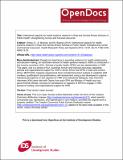Institutional capacity for health systems research in East and Central African Schools of Public Health: strengthening human and financial resources
| dc.contributor.author | Simba, Daudi | |
| dc.contributor.author | Mukos, Aggrey | |
| dc.contributor.author | Bazeyo, William | |
| dc.date.accessioned | 2014-12-10T11:34:21Z | |
| dc.date.available | 2014-12-10T11:34:21Z | |
| dc.date.issued | 2014-06-02 | |
| dc.identifier.citation | Simba, D., A. Mukose, and W. Bazeyo (2014) 'Institutional capacity for health systems research in East and Central African Schools of Public Health: strengthening human and financial resources'. Health Research Policy and Systems 2014, 12:23 doi:10.1186/1478-4505-12-23 | en_GB |
| dc.identifier.issn | 1478-4505 | |
| dc.identifier.uri | https://opendocs.ids.ac.uk/opendocs/handle/20.500.12413/5419 | |
| dc.description.abstract | BACKGROUND: Despite its importance in providing evidence for health-related policy and decision-making, an insufficient amount of health systems research (HSR) is conducted in low-income countries (LICs). Schools of public health (SPHs) are key stakeholders in HSR. This paper, one in a series of four, examines human and financial resources capacities, policies and organizational support for HSR in seven Africa Hub SPHs in East and Central Africa. METHODS: Capacity assessment done included document analysis to establish staff numbers, qualifications and publications; self-assessment using a tool developed to capture individual perceptions on the capacity for HSR and institutional dialogues. Key informant interviews (KIIs) were held with Deans from each SPH and Ministry of Health and non-governmental officials, focusing on perceptions on capacity of SPHs to engage in HSR, access to funding, and organizational support for HSR. RESULTS: A total of 123 people participated in the self-assessment and 73 KIIs were conducted. Except for the National University of Rwanda and the University of Nairobi SPH, most respondents expressed confidence in the adequacy of staffing levels and HSR-related skills at their SPH. However, most of the researchers operate at individual level with low outputs. The average number of HSR-related publications was only <1 to 3 per staff member over a 6-year period with most of the publications in international journals. There is dependency on external funding for HSR, except for Rwanda, where there was little government funding. We also found that officials from the Ministries of Health often formulate policy based on data generated through ad hoc technical reviews and consultancies, despite their questionable quality. CONCLUSIONS: There exists adequate skilled staff for HSR in the SPHs. However, HSR conducted by individuals, fuelled by Ministries’ of Health tendency to engage individual researchers, undermines institutional capacity. This study underscores the need to form effective multidisciplinary teams to enhance research of immediate and local relevance. Capacity strengthening in the SPH needs to focus on knowledge translation and communication of findings to relevant audiences. Advocacy is needed to influence respective governments to allocate adequate funding for HSR to avoid donor dependency that distorts local research agenda. | en_GB |
| dc.description.sponsorship | DFID | en_GB |
| dc.publisher | Springer | en_GB |
| dc.rights | This is an Open Access article distributed under the terms of the Creative Commons Attribution License (http://creativecommons.org/licenses/by/2.0), which permits unrestricted use, distribution, and reproduction in any medium, provided the original work is properly credited. The Creative Commons Public Domain Dedication waiver (http://creativecommons.org/publicdomain/zero/1.0/) applies to the data made available in this article, unless otherwise stated. | en_GB |
| dc.rights.uri | http://creativecommons.org/licenses/by/2.0/ | en_GB |
| dc.subject | Economic Development | en_GB |
| dc.subject | Health | en_GB |
| dc.title | Institutional capacity for health systems research in East and Central African Schools of Public Health: strengthening human and financial resources | en_GB |
| dc.type | Article | en_GB |
| dc.rights.holder | © 2014 Simba et al.; licensee BioMed Central Ltd. | en_GB |
| dc.identifier.externaluri | http://www.health-policy-systems.com/content/12/1/23/abstract | en_GB |
Files in this item
This item appears in the following Collection(s)
Except where otherwise noted, this item's license is described as This is an Open Access article distributed under the terms of the Creative Commons Attribution License (http://creativecommons.org/licenses/by/2.0), which permits unrestricted use, distribution, and reproduction in any medium, provided the original work is properly credited. The Creative Commons Public Domain Dedication waiver (http://creativecommons.org/publicdomain/zero/1.0/) applies to the data made available in this article, unless otherwise stated.


